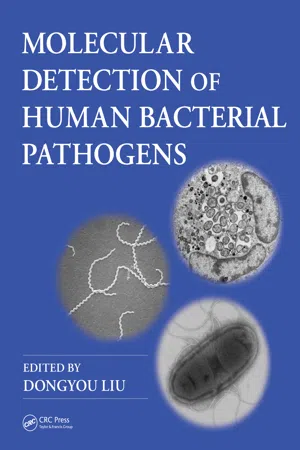
eBook - PDF
Molecular Detection of Human Bacterial Pathogens
Dongyou Liu, Dongyou Liu
This is a test
- 1,278 Seiten
- English
- PDF
- Über iOS und Android verfügbar
eBook - PDF
Molecular Detection of Human Bacterial Pathogens
Dongyou Liu, Dongyou Liu
Angaben zum Buch
Inhaltsverzeichnis
Quellenangaben
Über dieses Buch
As more original molecular protocols and subsequent modifications are described in the literature, it has become difficult for those not directly involved in the development of these protocols to know which are most appropriate to adopt for accurate identification of bacterial pathogens. Molecular Detection of Human Bacterial Pathogens addresses th
Häufig gestellte Fragen
Wie kann ich mein Abo kündigen?
Gehe einfach zum Kontobereich in den Einstellungen und klicke auf „Abo kündigen“ – ganz einfach. Nachdem du gekündigt hast, bleibt deine Mitgliedschaft für den verbleibenden Abozeitraum, den du bereits bezahlt hast, aktiv. Mehr Informationen hier.
(Wie) Kann ich Bücher herunterladen?
Derzeit stehen all unsere auf Mobilgeräte reagierenden ePub-Bücher zum Download über die App zur Verfügung. Die meisten unserer PDFs stehen ebenfalls zum Download bereit; wir arbeiten daran, auch die übrigen PDFs zum Download anzubieten, bei denen dies aktuell noch nicht möglich ist. Weitere Informationen hier.
Welcher Unterschied besteht bei den Preisen zwischen den Aboplänen?
Mit beiden Aboplänen erhältst du vollen Zugang zur Bibliothek und allen Funktionen von Perlego. Die einzigen Unterschiede bestehen im Preis und dem Abozeitraum: Mit dem Jahresabo sparst du auf 12 Monate gerechnet im Vergleich zum Monatsabo rund 30 %.
Was ist Perlego?
Wir sind ein Online-Abodienst für Lehrbücher, bei dem du für weniger als den Preis eines einzelnen Buches pro Monat Zugang zu einer ganzen Online-Bibliothek erhältst. Mit über 1 Million Büchern zu über 1.000 verschiedenen Themen haben wir bestimmt alles, was du brauchst! Weitere Informationen hier.
Unterstützt Perlego Text-zu-Sprache?
Achte auf das Symbol zum Vorlesen in deinem nächsten Buch, um zu sehen, ob du es dir auch anhören kannst. Bei diesem Tool wird dir Text laut vorgelesen, wobei der Text beim Vorlesen auch grafisch hervorgehoben wird. Du kannst das Vorlesen jederzeit anhalten, beschleunigen und verlangsamen. Weitere Informationen hier.
Ist Molecular Detection of Human Bacterial Pathogens als Online-PDF/ePub verfügbar?
Ja, du hast Zugang zu Molecular Detection of Human Bacterial Pathogens von Dongyou Liu, Dongyou Liu im PDF- und/oder ePub-Format sowie zu anderen beliebten Büchern aus Médecine & Santé publique, administration et soins. Aus unserem Katalog stehen dir über 1 Million Bücher zur Verfügung.
Information
Inhaltsverzeichnis
- Front Cover
- Contents
- Preface
- Editor
- Contributors
- Chapter 1: Introductory Remarks
- Chapter 2: Actinomadura
- Chapter 3: Actinomyces
- Chapter 4: Atopobium
- Chapter 5: Bifidobacterium
- Chapter 6: Corynebacterium
- Chapter 7: Cryptobacterium
- Chapter 8: Gardnerella
- Chapter 9: Gordonia
- Chapter 10: Micrococcus and Kocuria
- Chapter 11: Mycobacterium
- Chapter 12: Nocardia
- Chapter 13: Propionibacterium
- Chapter 14: Rhodococcus
- Chapter 15: Saccharopolyspora
- Chapter 16: Streptomyces
- Chapter 17: Tropheryma
- Chapter 18: Tsukamurella
- Chapter 19: Abiotrophia
- Chapter 20: Aerococcus
- Chapter 21: Bacillus
- Chapter 22: Enterococcus
- Chapter 23: Granulicatella
- Chapter 24: Lactobacillus
- Chapter 25: Leuconostoc
- Chapter 26: Listeria
- Chapter 27: Paenibacillus
- Chapter 28: Staphylococcus
- Chapter 29: Streptococcus
- Chapter 30: Acidaminococcus
- Chapter 31: Anaerococcus, Parvimonas, and Peptoniphilus
- Chapter 32: Catabacter
- Chapter 33: Clostridium
- Chapter 34: Dialister
- Chapter 35: Eubacterium
- Chapter 36: Finegoldia
- Chapter 37: Mogibacterium
- Chapter 38: Peptostreptococcus
- Chapter 39: Tannerella
- Chapter 40: Veillonella
- Chapter 41: Mycoplasma
- Chapter 42: Ureaplasma
- Chapter 43: Bacteroides
- Chapter 44: Capnocytophaga
- Chapter 45: Chlamydia
- Chapter 46: Chlamydophila
- Chapter 47: Elizabethkingia, Chryseobacterium, and Bergeyella
- Chapter 48: Fusobacterium
- Chapter 49: Leptotrichia and Leptotrichia-Like Organisms
- Chapter 50: Porphyromonas
- Chapter 51: Prevotella
- Chapter 52: Anaplasma
- Chapter 53: Bartonella
- Chapter 54: Brucella
- Chapter 55: Ehrlichia
- Chapter 56: Ochrobactrum
- Chapter 57: Orientia
- Chapter 58: Rickettsia
- Chapter 59: Achromobacter
- Chapter 60: Bordetella
- Chapter 61: Burkholderia
- Chapter 62: Eikenella
- Chapter 63: Kingella
- Chapter 64: Laribacter
- Chapter 65: Neisseria
- Chapter 66: Ralstonia
- Chapter 67: Acinetobacter
- Chapter 68: Aeromonas
- Chapter 69: Aggregatibacter
- Chapter 70: Cardiobacterium
- Chapter 71: Cedecea
- Chapter 72: Citrobacter
- Chapter 73: Coxiella
- Chapter 74: Enterobacter
- Chapter 75: Escherichia
- Chapter 76: Francisella tularensis
- Chapter 77: Haemophilus
- Chapter 78: Klebsiella
- Chapter 79: Legionella
- Chapter 80: Moraxella
- Chapter 81: Pasteurella
- Chapter 82: Photobacterium
- Chapter 83: Plesiomonas
- Chapter 84: Proteus
- Chapter 85: Providencia
- Chapter 86: Pseudomonas
- Chapter 87: Salmonella
- Chapter 88: Serratia
- Chapter 89: Shigella
- Chapter 90: Stenotrophomonas
- Chapter 91: Vibrio
- Chapter 92: Yersinia
- Chapter 93: Arcobacter
- Chapter 94: Campylobacter
- Chapter 95: Helicobacter
- Chapter 96: Borrelia
- Chapter 97: Leptospira
- Chapter 98: Treponema
- Chapter 99: Pan-Bacterial Detection of Sepsis-Causative Pathogens
- Chapter 100: Metagenomic Approaches for Bacterial Detection and Identification
- Back Cover